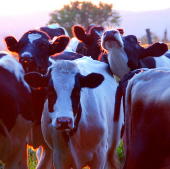Reducing Yogurt’s Carbon Footprint
From “greener” cows to substituting rail for trucks to more efficient water use, Stonyfield is systematically greening its supply chain.
Leading Sustainable Organizations

Stonyfield has optimized its business for rail instead of truck transport and worked to reduce “methane-creating cow burps” by using a grass-based rather than a grain-based diet.
Image courtesy of Flickr user paul+photos=moody.
The second in our series of mini Q&As from the virtual panel with MIT Sloan’s Jason Jay, Stonyfield Farm’s Wood Turner and SAP’s Peter Graf. You can watch the archived video panel here.
Do you have examples of how the [Stonyfield sustainability] changes have made the enterprise more sustainable? A gallon of milk has the same carbon footprint as a gallon of gasoline. What actions can materially reduce this footprint?
Turner: Clearly, you’ve just made the case for deep supply chain engagement, which we are very focused on. Simply by virtue of measuring our impact comprehensively, we recognized that we needed to attack enteric emissions on farms – essentially the methane-creating cow burps – and the transportation of finished product to the customer.
Our Greener Cow project, which we started in 2009, has shown very promising results in terms of reduced greenhouse gas emissions that can result from a diet of feed that’s more appropriate for cows: namely a grass-based rather than a grain-based diet. With the critical pasture requirement for organic milk – Stonyfield only uses organic milk – we’re already in a leadership position here at Stonyfield, but we want to go further to make sure that we can see the full potential of an effort like this.
We also have worked hard to optimize our business for rail, and between 2006 and 2010, we logged over 400,000 miles of rail transport in getting our yogurt to Western markets. Rail uses eleven times less fuel than trucks, so we’re already significantly reducing the impact of getting our products to market. We’ve become incredibly passionate advocates in trying to get other businesses to take advantage of the opportunities we have. It’s real impact and real costs that we’re avoiding. It takes commitment and focus – which as you might imagine scares some companies away – but for us, it’s just how we do business.

Comment (1)
globalingenieros